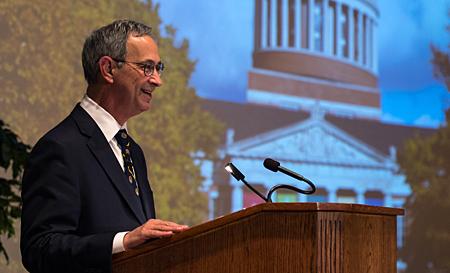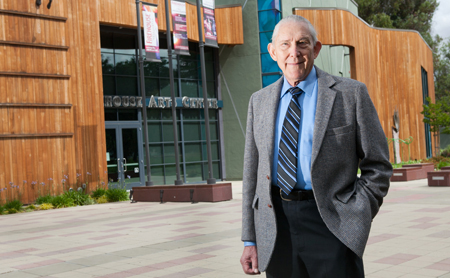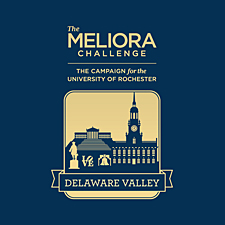Regional Campaign Launched in Delaware Valley
On June 6, the University launched the Delaware Valley regional campaign for The Meliora Challenge: The Campaign for the University of Rochester, at the National Constitution Center in Philadelphia.
University Trustee and George Eastman Circle member Thomas R. Sloan ’65, ’67 (MS), vice chair of East Coast efforts for the Campaign, welcomed more than 100 University alumni, parents, and friends to an evening that allowed them to celebrate, reconnect with, and take pride in Rochester.
In his remarks, Sloan provided an overview of the goals of The Meliora Challenge and emphasized the importance of regional support. George Eastman Circle members Neil Cullen ’64 and Betsey Cullen ’66, cochairs of the Delaware Valley regional campaign, will lead the region’s efforts to raise $12.5 million and build on the region’s George Eastman Circle presence by surpassing 100 memberships by June 30, 2016.
Thanks to the leadership of George Eastman Circle member Joseph Serletti ’82M (MD), ’88M (Res), chair of the Delaware Valley Regional Cabinet, the region has already raised more than $9.5 million. Regional Cabinets are key University volunteer structures that are helping to raise funds and awareness for the Campaign across the country.
Among those who gave remarks during the program was Galen Dole ’14, a music performance major with minors in mathematics and psychology in the School of Arts and Sciences. Dole, a Halee and David Baldwin Undergraduate Scholarship recipient, spoke on his eclectic coursework and shared ways he’s been able to use his education outside the classroom. He plans to attend medical school, after completing the Kauffman Entrepreneurial Year Program.
Eastman students soprano Adelaide Boedecker ’13E (MM) and accompanist Heather McEwen Goldman ’13E (MM) closed the evening with a moving musical performance.
The launch in Philadelphia is the University’s fourth formal, regional campaign kickoff, following previous launches in San Francisco, Chicago, and Boston. In March, the University also began a series of Campaign events that will be held throughout Florida. University Trustees and George Eastman Circle members Barry Florescue ’66 and Alan Hilfiker ’60 are leading Campaign celebrations along Florida’s coasts.
To view photos from the event, click here.
Values and Action

A couple days from now, the University Year will come to an end. Being a time of year when goals are reviewed and “numbers” have heightened significance, I would like to share progress in a specific area that many of you have helped make possible.
Throughout our Campaign, the George Eastman Circle has been the embodiment of our momentum. Over the last six years, the Eastman Circle’s expansion has been astounding. Here’s a look at how, together, we have developed this important group over the last three years:
Year/Memberships
• 2010—1,407
• 2011—1,800
• 2012—2,233
As of May 31, we now have 2,635 memberships and are growing every month. At our current pace, we are on track to exceed our goal of 3,300 memberships by June 30, 2016! This is a testament to what we can do when we work together.
While expanding the Eastman Circle remains an important priority, it is equally important that all current members renew their memberships. I’m happy to report that our Charter Members are actively renewing their memberships—34 percent upgraded their annual pledge and 16 percent are now giving at a full membership level higher.
The Annual Fund is the lifeblood of our institution. For those of you who are George Eastman Circle members, I would like to thank you for providing the continuous leadership and inspiration that is helping us reach our goals of 3,300 memberships and $130 million for the Annual Fund during The Meliora Challenge.
Such wonderful support has me asking, where can we be at this time next year?
George Eastman Circle members: if you haven’t already, please remember to make your membership payment before June 30. If your membership is up for renewal this year, I encourage you to renew today.
To pay your George Eastman Circle pledge, click here; to renew your Charter Membership, click here.
Meliora!
James D. Thompson
Senior Vice President
Chief Advancement Officer
DiMarzo Cancer Survivorship Program Established
 From left: Richard DiMarzo; Samual E. Durand Chair Jonathan Friedberg, M.D., director of the Cancer Center; Head Nurse of the Judy DiMarzo Cancer Survivorship Program Alicia Coffin, M.S., R.N., O.C.N.; and Judy's Fund representative Paul Hanrahan
From left: Richard DiMarzo; Samual E. Durand Chair Jonathan Friedberg, M.D., director of the Cancer Center; Head Nurse of the Judy DiMarzo Cancer Survivorship Program Alicia Coffin, M.S., R.N., O.C.N.; and Judy's Fund representative Paul Hanrahan
More and more people are beating cancer because of breakthroughs in research and treatment, earlier detection, and more accurate diagnoses. For many recovering patients, and their families and physicians, these triumphs bring new challenges, such as the delayed or long-term physical and psychological effects of cancer and its treatment.
The James P. Wilmot Cancer Center at the University of Rochester Medical Center is helping this increasing number of patients work through the complexities of cancer survivorship with the first comprehensive survivorship program in the region, the Judy DiMarzo Survivorship Program.
Funded by a generous gift from “Judy’s Fund: Hope for Cancer Survivors,” the program will serve as the “next step” in a patient’s care after completing cancer treatment. Judy DiMarzo, the namesake of Judy’s Fund and now the survivorship program, lost a nine-year battle with lymphoma in 2009. Judy’s Fund was established through a generous commitment from her husband, Richard DiMarzo, family, friends, and other community-based support.
“While Judy was receiving treatment, our family learned so much about the meaningful difference the Cancer Center has made on the community and patients that are cared for each day,” said Richard. “To give back to a place that touched our lives so deeply will not only help create a program to better support cancer survivors, but also allow us to have Judy in the minds of others—a true gift for our family.”
Patients in the program are able to continue to work with the team who treated their cancer. Starting with lymphoma and breast cancer, the program will be implemented in all areas of cancer treatment in the next six months. Eventually the program will become a regional resource for all cancer survivors, regardless of where they received cancer treatment.
“Survivorship is a key phase in the continuum of care for cancer patients as our focus turns from treatment to ongoing management of potential long-term effects and overall wellness,” said Samuel E. Durand Chair Jonathan Friedberg, M.D., director of the Wilmot Cancer Center. “We estimate that there are approximately 2,780 additional cancer survivors in Monroe County every year—more than 25,000 in a 10-year period—making this program essential for the community we serve.”
Wilmot scientists have a long history of studying the risks of second cancers, sleep disorders, nausea and other post-treatment effects in cancer survivors. The clinical survivorship program is just one example of how research at Wilmot is quickly translated into better treatments and outcomes.
To read more about the Judy DiMarzo Survivorship Program, click here.
To read about Judy’s Fund and the cancer survivorship initiative for The Meliora Challenge, click here.
46th Annual Garden Party
 President Joel Seligman addresses the 46th Annual Garden Party
President Joel Seligman addresses the 46th Annual Garden Party
More than 550 friends of the University gathered at the Memorial Art Gallery to hear President Joel Seligman’s address at the 46th Annual Garden Party, on June 4.
Although it had no formal title, President Seligman’s address could have easily been titled “An Accelerating Pace of Change.” The University has come an extraordinarily long way since the time of President Martin Brewer Anderson and the United States Hotel. Beginning with a look back at those earliest decades, President Seligman’s remarks moved through the University’s history up to present day.
Highlighting the University’s continued growth, President Seligman provided updates on several development projects, citing the ribbon cutting for Raymond F. LeChase Hall, the new home for the Margaret Warner Graduate School of Education and Human Development; the ribbon cutting inaugurating the Centennial Sculpture Park at the Memorial Art Gallery; and the groundbreaking of a transformational project for the University and the surrounding community—College Town.
Opening in 2014, College Town will be a 500,000 square-foot, mixed-use development on 14 acres of Mt. Hope Avenue between Elmwood Avenue and Crittenden Boulevard. The project features street-level retail stores, restaurants, office spaces with residential space in the floors above, a Barnes & Noble Bookstore, a 150-room Hilton Garden Inn and Conference Center, and a new parking garage with 1,560 parking spaces.
Much of the University's progress can be attributed to the on-going success of The Meliora Challenge: The Campaign for the University of Rochester. President Seligman reported on progress toward student and faculty support goals which have helped the Campaign achieve 78 percent of its $1.2 billion goal. He shared appreciation for recent notable gifts, including 14 endowed professorships, helping to give the University a total of 64 new endowed professorships since the beginning of the Campaign. The University seeks to create at least 80 new endowed professorships by June 30, 2016.
President Seligman closed plans for the future, saying no challenges will ever keep us from dreaming big. “Like all universities and colleges today, we face challenges,” said Seligman. “And yet more than any other social institution in our country today, universities like the University of Rochester combine freedom, creativity, incredibly bright faculty, students and staff, loyal alumni, and friends who share a vision that we are moving toward a better world.”
To read or watch a video of the President’s address, click here.
Williams First in New Scholarships Program
 To bolster student support, the University has launched the George Eastman Circle Scholarships Program, a new current-use scholarship initiative for The Meliora Challenge: The Campaign for the University of Rochester.
To bolster student support, the University has launched the George Eastman Circle Scholarships Program, a new current-use scholarship initiative for The Meliora Challenge: The Campaign for the University of Rochester.
As a component of the Campaign, George Eastman Circle Scholarships will complement the endowed scholarships program by providing the opportunity for individuals to have an immediate impact on a student’s education. H. Robert (Bob) Williams ’57E (MM), a Charter Member of the George Eastman Circle, is the first to create a scholarship through this new program.
To read about how Bob Williams is helping students at the University, click here. For more information on the George Eastman Circle Scholarships Program, you can read the pamphlet online here.
